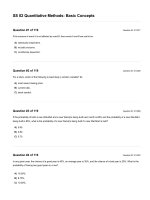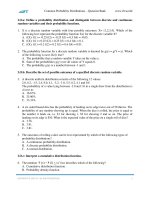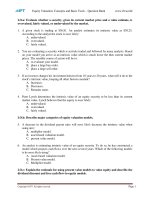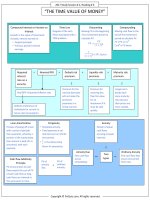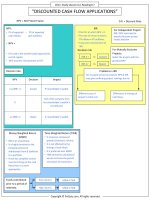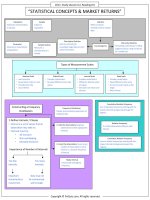CFA 2018 SS 02 reading 09 probability concepts
Bạn đang xem bản rút gọn của tài liệu. Xem và tải ngay bản đầy đủ của tài liệu tại đây (158.79 KB, 8 trang )
Probability Concepts
2.
PROBABILITY, EXPECTED VALUE, AND VARIANCE
Random variable: A variable that has uncertain
outcomes is referred to as random variable e.g. the
return on a risky asset.
Empirical (or statistical) probability: It is a probability
based on observations obtained from probability
experiments (historical data). The empirical frequency
of an event E is the relative frequency of event E i.e.
Event: An event is an outcome or a set of outcomes of a
random process e.g. 10% return earned by the portfolio
or tossing a coin three times.
• When an event is certain or impossible to occur, it is
not a random outcome.
Probability: Probability is a measure of the likelihood or
chance that an event will occur in the future.
P(E) =
୰୭ୠୟୠ୧୪୧୲୷୭୴ୣ୬୲
୭୲ୟ୪୰୭ୠୟୠ୧୪୧୲୷
• Empirical probability of an event cannot be
computed for an event with no historical record or
for an event that occurs infrequently.
Example:
Total sample of dividend changes = 16,189.
• If an event is possible to occur, it has a probability
between 0 and 1.
• If an event is impossible to occur, it has a probability
of 0.
• If an event is certain to occur, it has a probability of 1.
Properties of a Probability:
1) The probability of any event ‘E’ is a number that lies
between 0 and 1 i.e.
0 ≤ P(E) ≤ 1
Where, P(E) = Probability of event E.
• Frequency of observations that ‘change in
dividends’ is increase = 14,911.
• Frequency of observations that ‘change in
dividends’ is decrease = 1,278.
Probability that a dividend change is a dividend
ଵସ,ଽଵଵ
increase =
≈ 0.92
ଵ,ଵ଼ଽ
Subjective probability: It is a probability based on
personal assessment, educated guesses, and estimates.
Priori probability: It is a probability based on logical
analysis, reasoning & inspection rather than on
observation or personal judgment.
• Priori and empirical probabilities are referred to as
objective probabilities.
2) The sum of the probabilities of any set of mutually
exclusive and exhaustive events always equals 1 e.g.
if there are three events A, B & C, then their
probabilities i.e. P(A) + P(B) + P(C) = 1.
Mutually exclusive events: When events are mutually
exclusive, events cannot occur at the same time e.g.
when a coin is tossed, the event of occurrence of a
head and the event of occurrence of a tail are mutually
exclusive events. The following events are mutually
exclusive.
• Event A: The portfolio earns a return = 8%.
• Event B: The portfolio earns a return < 8%.
Exhaustive events: When events are exhaustive, it means
that all possible outcomes are covered by the events
e.g. the following events are exhaustive.
• Event A: The portfolio earns a return = 8%.
• Event B: The portfolio earns a return < 8%.
• Event C: The portfolio earns a return > 8%.
Odds for Event E can be stated as:
E=
୰୭ୠୟୠ୧୪୧୲୷୭
=
ଵି୰୭ୠୟୠ୧୪୧୲୷୭
()
[ଵିሺሻ]
For example, given odds for E = "a to b,"
it implies that:
• For ‘a’ occurrences of E, we expect ‘b’ cases of
non-occurrence.
Probability of E =
ୟ
(ୟାୠ)
Odds against Event E can be stated as:
E=
[ଵିሺሻ]
ሺሻ
For example, given odds against E =“a to b,"
that the
ୠ
Probability of E =
it implies
(ୟାୠ)
In the probability distribution of the random variable,
each random outcome is assigned a probability.
–––––––––––––––––––––––––––––––––––––– Copyright © FinQuiz.com. All rights reserved. ––––––––––––––––––––––––––––––––––––––
FinQuiz Notes – 2 0 1 7
Reading 9
Reading 9
Probability Concepts
Example:
Suppose odds for E = “1 to 7." Thus, total cases = 1 + 7 =
8. It means that out of 8 cases
there is 1 case of
occurrence and 7 cases of non-occurrence.
FinQuiz.com
probability of A and B is the sum of the probabilities of
their common outcomes.
• P(AB) = P(BA).
The probability of E = 1/ (1 + 7) = 1/ 8.
Example:
Suppose,
•
•
•
•
Winning probability = 1 / 16
Losing probability = 15 / 16
Profit when a person wins = $15
Loss when a person losses = $ -1
Expected profit = (1 / 16)($15) + (15/ 16)(-$1) = $0
Practice: Example 1,
Volume 1, Reading 9.
1) Unconditional Probability: An unconditional
probability is the probability of an event occurring
regardless of other events e.g. the probability of this
event A denoted as P(A). It may be viewed as standalone probability. It is also called marginal
probabilities.
2) Conditional Probability: A conditional probability is the
probability of an event occurring, given that another
event has already occurred.
Probability of A, given B.
)ܤܣ(ܲ ܤ݀݊ܽܣ݂ݕݐ݈ܾܾ݅݅ܽݎݐ݊݅ܬ
=
→ ܲ( ≠ )ܤ0
ܲ()ܤ
ܲܤ݂ݕݐ݈ܾܾ݅݅ܽݎ
P(A and B) = P(AB) = P(A|B) × P(B)
P(B and A) = P(BA) = P(B|A) × P(A)
Practice: Example 2,
Volume 1, Reading 9.
Addition Rule for Probabilities: The probability that event
A or B will occur (i.e. at least one of the two events
occurs) is found as follows:
P(A or B) = P(A) + P(B) – P *(A and B)
NOTE:
The conditional probability of an event can be greater
than, equal to, or less than the unconditional probability,
depending on the facts.
Example:
Unconditional Probability: The probability that the stock
earns a return above the risk-free rate (event A).
ܲ( )ܣ
Sumoftheprobabilitiesofstockreturnsabovetherisk − freerate
=
Sumoftheprobabilitiesofࢇpossiblereturns(i. e.1)
Conditional Probability: The probability that the stock
earns a return above the risk-free rate (event A), given
that the stock earns a positive return (event B).
P(A|B) =
ࡼሺ|ሻ =
Multiplication Rule for Probability: For two events, A and
B, the joint probability that both events will happen is
found as follows:
Types of Probability:
P(A|B)
The conditional probability of A given that B has
occurred:
ୗ୳୫୭୲୦ୣ୮୰୭ୠୟୠ୧୪୧୲୧ୣୱ୭ୱ୲୭ୡ୩୰ୣ୲୳୰୬ୱୟୠ୭୴ୣ୲୦ୣ୰୧ୱ୩୰ୣୣ୰ୟ୲ୣ
*To avoid double counting of probabilities of shared outcomes
When events A and B are mutually exclusive, P(AB) = 0;
thus, the addition rule can be simplified as:
P(A or B) = P(A) + P(B)
Practice: Example 3,
Volume 1, Reading 9.
Independent Events: Two events are independent if the
occurrence of one of the events does not affect the
probability of the other event. Two events A and B are
independent if
ୗ୳୫୭୲୦ୣ୮୰୭ୠୟୠ୧୪୧୲୧ୣୱ୭୰ୟ୪୪୰ୣ୲୳୰୬ୱவ%
Joint Probability: The probability of occurrence of all
events is referred to as joint probability. For example, the
joint probability of A and B denoted as P(AB) read as the
P(B |A) = P(B)
Or if
P(A |B) = P(A)
Reading 9
Probability Concepts
Dependent Events: Two events are dependent when the
probability of occurrence of one event depends on the
occurrence of the other.
Multiplication Rule for Independent Events:
P(A and B) = P(AB) = P(A) × P(B)
P(A and B and C) = P(ABC) = P(A) × P(B) × P(C)
FinQuiz.com
P(A) = P(A│S) P(S) + P(A│SC) P(SC)
0.55 = P(A│S) (0.55) + 0.40 (0.45)
P(A│S) = [0.55 – 0.40 (0.45)] / 0.55 = 0.673
Source: Example 7, CFA® Curriculum, Volume 1, Reading 9.
Expected value of a random variable: The expected
value of a random variable is the probability-weighted
average of the possible outcomes of the random
variable.
Practice: Example 4 & 5,
Volume 1, Reading 9.
Variance of a random variable: The variance of a
random variable is the expected value of squared
deviations from its expected value:
Example:
Suppose the unconditional probability that a fund is a
loser in either period 1 or 2 = 0.50 i.e.
• P(fund is a period 1 loser) = 0.50
• P(fund is a period 2 loser) = 0.50
Calculating the probability that fund is a Period 2 loser
and fund is a Period 1 loser i.e. P(fund is a Period 2 loser
and fund is a Period 1 loser).
Using the multiplication rule for independent events:
P(Fund is a period 2 loser and fund is a period 1 loser) =
P(fund is a period 2 loser) × P(fund is a period 1 loser) =
0.50 × 0.50 = 0.25
σ2 (X) = E {[X – E (X)] 2 }
where,
σ2 (X) = variance of random variable X
• Variance ≥ 0.
• When variance = 0, there is no dispersion or risk →
the outcome is certain and quantity X is not random
at all.
• The higher the variance, the higher the dispersion or
risk, all else equal.
Standard deviation: It is the positive square root of
variance. It is easier to interpret than variance because
it is in the same units as the random variable.
Source: Example 6, CFA® Curriculum, Volume 1, Reading 9.
Example:
Complement Rule: For an event or scenario S, the event
not-S is called the complement of S and is denoted as
SC. Since either S or not-S must occur,
P(S) +
P(SC)
=1
The Total Probability Rule: According to the total
probability rule, the probability of any event P(A) can be
stated as a weighted average* of the probabilities of the
event, given scenarios i.e. P(A│S1).
EPS ($)
Probability
2.60
0.15
2.45
0.45
2.20
0.24
2.00
0.16
1.00
*where, weights = P(S1) × P(A│S1)
It is expressed as follows:
P(A) = P(AS) + P(ASC) = P(A│S) P(S) + P(A│SC) P(SC)
P(A) = P(AS1) + P(AS2) +… P(ASn)
= P(A│S1) P(S1) + P(A│S2) P(S2)+…P(A│Sn) P(Sn)
Where, S1, S2…,Sn are mutually exclusive and exhaustive
scenarios or events.
• The total probability rule states an unconditional
probability in terms of conditional probabilities.
Expected value of EPS = E (EPS) = 0.15 ($2.60) + 0.45
($2.45) + 0.24 ($2.20) + 0.16 ($2.00) = $2.3405
σ2 (EPS) = P ($2.60) [$2.60 – E (EPS)] 2 + P ($2.45) [$2.45 – E
(EPS)] 2 + P ($2.20) [$2.20 – E (EPS)] 2 + P ($2.0)
[$2.0 – E (EPS)] 2
σ2 (EPS) = 0.15 ($2.60 – $2.34)2 + 0.45 ($2.45 – $2.34)2 +
0.24 ($2.20 – $2.34)2 + 0.16 ($2.00 – $2.34)2
= 0.01014 + 0.005445 + 0.004704 + 0.018496
= $0.038785
S.D of EPS = ඥ$0.038785 = $0.20
Source: Example 8 & 9, CFA® Curriculum, Volume 1, Reading 9.
Example:
Calculating P(A│S). Suppose, P(A) = 0.55, P(S) = 0.55,
P(SC) = 0.45 and P(A│SC) = 0.40.
Conditional expected values: The conditional expected
value refers to the expected value of a random variable
X given an event or scenario S. It is denoted as E(X│S) i.e.
Reading 9
Probability Concepts
E(X|S) = P(X1IS)X1+ P(X2IS)X2 …+P(XnIS)Xn
The unconditional probability that EPS will be $2.45
= 0.60 × 0.75 = 0.45
Conditional Variance: The conditional variance refers to
the variance of a random variable X given an event or
scenario.
0. 25
EPS = $2.60 with
Prob. = 0.15
Prob. Of declining
interest rates = 0.60
The Total Probability Rule for Expected Value: It is
expressed as follows:
E(X) = E(X|S)P(S)+ E(X|SC) P(SC)
FinQuiz.com
0. 75
EPS = $2.45 with
Prob. = 0.45
0. 60
EPS = $2.20 with
Prob. = 0.24
E(EPS) = $2.34
E(X) = E(X|S1)P(S1)+ E(X|S2) P(S2)+…+E(X|Sn) P(Sn)
Prob. Of stable
interest rates = 0.40
where,
E (X│Si) = Expected value of X given Scenario i
P(Si)
= Probability of Scenario i
0.40
EPS = $2.00 with
Prob. = 0.16
S1, S2...,Sn are mutually exclusive and exhaustive
scenarios or events.
Example: Suppose,
• Current Expected EPS of BankCorp = $2.34
• Probability that BankCorp will operate in a declining
interest rate environment in the current fiscal year =
0.60.
• Probability that BankCorp will operate in a stable
interest rate environment in the current fiscal year =
0.40.
Under declining interest rate environment:
Thus,
E (EPS │ declining interest rate environment) =
0.25($2.60) + 0.75($2.45) = $2.4875
When interest rates are stable:
E (EPS │stable interest rate environment) = 0.60($2.20) +
0.40($2.00) = $2.12
E (EPS)={E (EPS │declining interest rate environment) ×
P(declining interest rate environment)} + {E(EPS
│stable interest rate environment) × P(stable
interest rate environment)}
• The probability that EPS will be $2.60 = 0.25
• The probability that EPS will be $2.45 = 0.75
The unconditional probability that EPS will be $2.60 =
Probability that BankCorp will operate in a declining
interest rate environment in the current fiscal year × The
probability that EPS will be $2.60 given declining interest
rate environment
The unconditional probability that EPS will be
$2.60 = 0.60 × 0.25 = 0.15
The unconditional probability that EPS will be $2.45 =
Probability that BankCorp will operate in a declining
interest rate environment in the current fiscal year × The
probability that EPS will be $2.45 given declining interest
rate environment
= $2.4875 (0.60) + $2.12 (0.40) = $2.3405 ≈ $2.34.
Calculation of Conditional variances i.e. the variance of
EPS given a declining interest rate environment and the
variance of EPS given a stable interest rate environment.
σ2 (EPS │ declining interest rate environment) =
P($2.6│declining interest rate environment) × [$2.60 E(EPS │ declining interest rate environment)2+ P($2.45 │
declining interest rate environment) × [$2.45 - E(EPS │
declining interest rate environment)2
= 0.25($2.60 - $2.4875)2+ 0.75($2.45 - $2.4875)2= 0.004219
σ2 (EPS │ stable interest rate environment)=P($2.2│stable
interest rate environment) × [$2.20 - E(EPS │stable
interest rate environment)2+ P($2.00│ stable interest rate
environment) × [$2.00 - E(EPS │stable interest rate
environment)2
= 0.60 ($2.20 – $2.12)2 + 0.40 ($2.00 – $2.12)2 = 0.0096
NOTE:
The unconditional variance of EPS = Expected value of
the conditional variances + Variance of conditional
expected values of EPS.
Reading 9
Probability Concepts
FinQuiz.com
Where,
Example:
Expected value of the conditional variances =
σ2 (EPS) = P (declining interest rate environment) × σ2
(EPS| declining interest rate environment) + P
(stable interest rate environment) × σ2 (EPS|
stable interest rate environment)
=0.60 (0.004219) + 0.40 (0.0096)
=0.006371
Suppose,
Variance of conditional expected values of EPS =
σ2 [E (EPS | interest rate environment)] = 0.60 ($2.4875 –
$2.34)2 + 0.40
($2.12 – $2.34)2
= 0.032414
Thus,
Unconditional Variance of EPS = 0.006371 + 0.032414
= 0.038785
Source: Example, CFA® Curriculum, Volume 1, Reading 9.
•
•
•
•
•
P(Bond defaults) = 0.06
P (Bond does not default) = 0.94
Return on T-bill → RF = 5.8%
Bond value when it defaults = $0.
Bond value when it does not default = $ (1 + R)
Expected value of bond = E (bond) = $0 × P(bond
defaults) + $ (1 + R) [1 – P(bond defaults)]
E (bond) = $ (1 + R) [1 – P(bond defaults)]
Since,
T-bill is risk-free,
Expected value of the T-bill per $1 invested = (1 + Rf)
is a certain value.
It
Calculating default premium:
Practice: Example 10,
Volume 1, Reading 9, P.
Expected value of Bond = Expected value of T-bill
$ (1 + R) [1 – P(bond defaults)] = (1 + Rf)
R = {(1 + Rf) / [1 – P(bond defaults)]} – 1
R = [1.058 / (1 – 0.06)] – 1 = 1.12553 – 1 = 0.12553 = 12.55%
Default risk premium = R – Rf = 12.55% - 5.8% = 6.75%
Source: Example 11, CFA® Curriculum, Volume 1, Reading 9.
3.
PORTFOLIO EXPECTED RETURN AND VARIANCE OF RETURN
Properties of Expected Value:
1. The expected value of a constant × random variable
= Constant × Expected value of the random variable
i.e.
E(wiRi) = wi E(Ri)
where,
When the returns on both assets tend to move together
i.e. there is a positive relationship between returns
Covariance of returns is positive (i.e. >0).
When the returns on both assets are inversely related
Covariance of returns is negative (i.e. < 0).
When returns on the assets are unrelated
of returns is 0.
wi = weight of variable i
Ri = random variable i
2. The expected value of a weighted sum of random
variables = Weighted sum of the expected values,
using the same weights i.e.
E(w1R1 + w2R2 +… +wnRn) = w1E(R1) + w2E(R2) +…+wnE(Rn)
Expected return on the portfolio: The expected return on
the portfolio is a weighted average of the expected
returns on the component securities i.e.
E(Rp) = E(w1R1 + w2R2 +…+wnRn)
=w1E(R1)+w2E(R2) + …+wnE(Rn)
Covariance: The covariance is a measure of how two
assets move together. Given two random variables Ri
and Rj, the covariance between Ri and Rj is stated as:
Covariance
• As the number of assets (securities) increases,
importance of covariance increases, all else equal.
• Like variance, covariance is difficult to interpret.
Important to Note:
• The covariance of a random variable with itself (own
covariance) is its own variance i.e.
Cov (R, R) = E {[R - E(R)] [R - E(R)]} = E {[R - E(R)] 2 }
= σ2(R)
• Cov (Ri, Rj) = Cov (Rj, Ri)
Covariance Matrix: It a square format of presenting
covariances.
SEE: Table7, Volume 1, Reading 9.
Cov(Ri, Rf) =
ߑୀଵ
[p(Ri
– ERi)(Rj – ERf)]
Portfolio variance: It is calculated as:
Reading 9
Probability Concepts
ߪ ൫ܴ ൯ = ߱ ߱ ݒܥ൫ܴ, ܴ ൯
FinQuiz.com
negative (inverse) linear relationship.
ଶ
ୀଵ ୀଵ
For example, given three assets with returns R1, R2 and R3,
portfolio variance is calculated as:
ߪ ଶ ൫ܴ ൯ = ߱ଵଶ ߪ ଶ ሺܴଵ ሻ + ߱ଶଶ ߪ ଶ ሺܴଶ ሻ + ߱ଷଶ ߪ ଶ ሺܴଷ ሻ
+ 2߱ଵ ߱ଶ ݒܥሺܴଵ , ܴଶ ሻ + 2߱ଵ ߱ଷ ݒܥሺܴଵ , ܴଷ ሻ
+ 2߱ଶ ߱ଷ ݒܥሺܴଶ , ܴଷ ሻ
NOTE:
• When the correlation is positive (negative): R1 = a +
bR2 + error
b > (<) 0.
• When the correlation is zero: R1 = a + bR2 + error
b
= 0.
NOTE:
Correlation only deals with linear relationships.
Where,
σ2 = Corresponding variance of each asset in the
portfolio
• The smaller the covariance between assets, the
greater the diversification benefits and the greater
the cost of not diversifying (in terms of risk-reduction
benefits forgone), all else equal.
When the returns on the three assets are independent,
covariances = 0 and S.D. of portfolio return would be:
Practice: Example 12,
Volume 1, Reading 9.
JOINT PROBABILITY FUNCTION:
Let, RA = Return on stock BankCorp and RB = Return on
stock NewBank.
Joint Probability Function of BankCorp and NewBank
Returns (Entries Are Joint Probabilities)
S.D. = [w21σ2 (R1) + w22σ2 (R2) + w23σ2 (R3)] ½.
Generally for n number of securities, we need to
estimate:
• n (n - 1 )/2 distinct covariances.
• n distinct variances.
Properties of Variance and Covariance:
a) The variance of a constant multiplied by a random
variable = Constant squared multiplied by the
variance of the random variable i.e.
σ2 (w×R) = w2 × σ2 × (R)
b) Variance of a constant = 0.
c) The variance of a constant + random variable =
Variance of the random variable.
d) The covariance between a constant and a random
variable is 0.
Correlation: The correlation between two random
variables, Ri, and Rj, is estimated as follows:
ρ (Ri, Rj) = Cov (Ri,Rj) ÷σ(Ri) σ(Rj)
• The value of correlation lies between -1 and + 1 i.e.
for two random variables, X and Y:
– 1 ≤ ߩሺܺ, ܻሻ ≤ +1
• When correlation = 0, variables are unrelated and
do not have any linear relationship.
• When correlation > 0, variables have positive linear
relationship.
• When correlation < 0, variables have negative
(inverse) linear relationship.
• When correlation = +1, variables have perfect
positive linear relationship.
• When correlation = -1, variables have perfect
RB = 20%
RB = 16%
RB = 10%
RA = 25%
0.20
0
0
RA = 12%
0
0.50
0
RA = 10%
0
0
0.30
Source: Table 12, CFA® Curriculum, Volume 1, Reading 9.
Expected return on BankCorp stock = 0.20(25%) +
0.50(12%) + 0.30(10%) = 14%.
Expected return on NewBank stock = 0.20(20%) +
0.50(16%) + 0.30(10%) = 15%
ݒܥሺܴ , ܴ ሻ = ܲ(ܴ, , ܴ, ) ൫ܴ, − ܴܧ ൯൫ܴ, − ܴܧ ൯
Cov(RA, RB) = P(25, 20) [(25 – 14)(20–15)] + P(12, 16) [(12 –
14)(16 – 15)] + P(10, 10)[(10 – 14) (10 – 15)]
= 0.20(11)(5) + 0.50(–2)(1) + 0.30(–4)(–5)
=11 – 1 + 6 = 16
Independent Random Variables: Two random variables
X and Y are independent if and only if:
P(X, Y) = P(X) P(Y)
• Independence is a stronger property compared to a
correlation of 0 because correlation deals with only
linear relationships.
Multiplication Rule for Expected Value of the Product of
Uncorrelated Random Variables: When two random
variables (e.g. X & Y) are uncorrelated,
Expected value of (XY)= Expected value of X × Expected
value of Y
E (XY) = E(X) E(Y)
Reading 9
4.1
Probability Concepts
FinQuiz.com
consensus) ×P(EPS met
consensus) + P(DriveMed
expands |EPS fell short of
consensus) × P(EPS fell short of
consensus)
= 0.75(0.45) + 0.20(0.30) +
0.05(0.25)
= 0.4, or 41%
Bayes' Formula
Bayes' formula is a method for updating a probability
given additional information. It is also called an inverse
probability. It is computed using the following formula:
Updated probability of event given the new information:
=
ܲݐ݂ݕݐ݈ܾܾ݅݅ܽݎℎ݁݊݁ݐ݊݁ݒ݁݊݁ݒ݅݃݊݅ݐܽ݉ݎ݂݊݅ݓ
ܷ݊ܿݐ݂ݕݐ݈ܾܾ݅݅ܽݎ݈ܽ݊݅ݐ݅݀݊ℎ݁݊݁݊݅ݐܽ݉ݎ݂݊݅ݓ
× ܲݐ݊݁ݒ݂݁ݕݐ݈ܾܾ݅݅ܽݎݎ݅ݎ
ܲሺ)ݐ݊݁ݒܧ|݊݅ݐܽ݉ݎ݂݊ܫ
ܲሺ݊݅ݐܽ݉ݎ݂݊ܫ|ݐ݊݁ݒܧሻ =
ܲ()ݐ݊݁ݒܧ
ܲሺ݊݅ݐܽ݉ݎ݂݊ܫሻ
Using the Bayes’ Formula, P(EPS exceeded consensus
given that DriveMed expands) is estimated as:
ܲሺݏ݀݊ܽݔ݁݀݁ܯ݁ݒ݅ݎܦ|ݏݑݏ݊݁ݏ݊ܿ݀݁݀݁݁ܿݔ݁ܵܲܧሻ
ܲሺ)ݏݑݏ݊݁ݏ݊ܿ݀݁݀݁݁ܿݔ݁ܵܲܧ|ݏ݀݊ܽݔ݁݀݁ܯ݁ݒ݅ݎܦ
=
ܲሺݏ݊݁ݏ݊ܿ݀݁݀݁݁ܿݔ݁ܵܲܧ
ܲሺݏ݀݊ܽݔ݁݀݁ܯ݁ݒ݅ݎܦሻ
= (0.75/0.41)(0.45) = 1.829268(0.45) = 0.823171
• The updated probability is referred to as the
posterior probability.
Diffuse priors: When the prior probabilities are equal,
they are referred to as diffuse priors.
Source: CFA® Curriculum, Volume 1, Reading 9.
Practice: Example 13,
Volume 1, Reading 9.
Important to Note: When the prior probabilities are
equal:
Probability of information given an event = Probability of
an event
given the
information.
Example:
Suppose three mutually exclusive and exhaustive events
i.e.
i. Last quarter's EPS of DriveMed exceeded the
consensus EPS estimate.
ii. Last quarter's EPS of DriveMed exactly met the
consensus EPS estimate.
iii. Last quarter's EPS of DriveMed fell short of the
consensus EPS estimate.
4.2
Principles of Counting
Multiplication Rule of Counting: If one event can occur in
n1 ways and a second event (given the first event) can
occur in n2 ways, then the number of ways the two
events can occur in sequence =n1× n2.
• Similarly, the number of ways the k events can occur
= (n1) (n2) (n3) … (nk).
• It is referred to as n factorial (n!) i.e.
n! = n (n – 1) (n – 2) (n – 3) …1
Multinomial Formula (General Formula for Labeling
Problems): The number of ways that n objects can be
assigned k different labels i.e. is given by:
݊!
݊ଵ ! ݊ଶ ! … ݊ !
Prior probabilities (or priors) of three events before any
new information are as follows:
• P(EPS exceeded consensus) = 0.45
• P(EPS met consensus) = 0.30
• P(EPS fell short of consensus) = 0.25
Suppose the new information is
DriveMed expands
and the conditional probabilities (likelihoods) are:
P(DriveMed expands | EPS exceeded consensus) = 0.75
P(DriveMed expands | EPS met consensus) = 0.20
P(DriveMed expands | EPS fell short of consensus) = 0.05
Calculating the unconditional probability for DriveMed
expanding i.e. P(DriveMed expands):
Combination Formula (Binomial Formula): A
combination is the number of ways to choose r objects
from a group of n objects without regard to order.
nܥ
= ൫൯ = ሺିሻ!!
!
• It is read as “n choose r” or “n combination r”.
where,
n = total number of objects
r = number of objects selected
Example:
P(DriveMed expands) = P(DriveMed expands |EPS
exceeded consensus) ×P(EPS
exceeded consensus) +
P(DriveMed expands |EPS met
In how many different ways 3 books can be read from a
list of 5 books if the order does not matter?
Reading 9
5 C3
Probability Concepts
= 5!/(5 – 3)!3!
=(5)(4)(3)(2)(1)/(2)(1)(3)(2)(1)=120/12=10 ways
NOTE:
5 C3
=
ହ!
ଶ!ଷ!
and 5C2 =
ହ!
Example:
In how many different ways 3 books can be read from a
list of 5 books if the order does matter?
5P3
ଷ!ଶ!
Suppose jurors want to select three companies out of a
group of five to receive the first-, second-, and thirdplace awards for the best annual report. In how many
ways can the jurors make the three awards?
Count ordered listings such as first place, New Company;
second place, Fir Company; third place, Well Company.
An ordered listing is known as a permutation.
Permutation: A permutation is any arrangement of r
objects selected from a total of n objects, when the
order of arrangement does matter.
nܲ
ൌ ሺିሻ!
!
FinQuiz.com
= 5! / (5 - 3)! = 5! / 2! =
ሺହሻሺସሻሺଷሻሺଶሻሺଵሻ
ሺଶሻሺଵሻ
= 120/ 2 = 60 ways
Summary:
• When the objective is to assign every object from a
total of n objects one of n slots (or tasks),
n
factorial should be used.
• When the objective is to count the number of ways
that n objects can be assigned k different labels,
multinomial formula should be used.
• When the objective is to count the number of ways
that r objectives can be selected from a total of n
when order in which they are selected does not
matter, combination formula should be used.
• When the objective is to count the number of ways
that r objectives can be selected from a total of n
when order in which they are selected does matter,
permutation formula should be used.
• When Multiplication rule of counting cannot be
used, the possibilities need to be counted one by
one, or by using more advanced techniques.
Practice: End of Chapter Practice
Problems for Reading 9.

